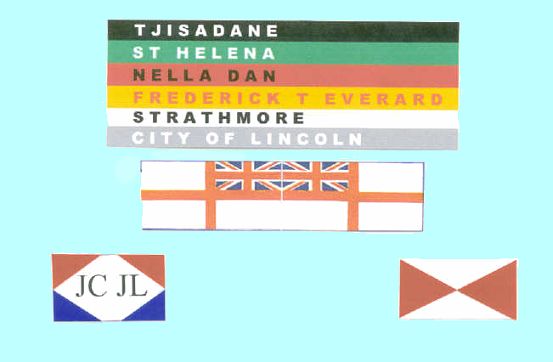|
NAMES, FUNNELS AND FLAGS IN MINIATURES by Bob Wilson |
|
|
|
Names, funnel emblems and flags have long been a
problem for the miniaturist. It is not so bad if the funnel has basic
colours such as red with a black top or even a single colour. I am no
artist, and the neat production of names, funnel emblems and flags has
given me problems for a long time. Flags I could simply leave off and even
names on miniatures were not really missed. Funnels, however, could not be
evaded and for many years I simply did the best I could. The advent of the
computer and zoom photocopier changed all that. I will begin with hull names. With all the various styles available in word processing packages, it is quite simple to produce any colour of name on any colour of hull and a few examples are shown below. When I prepare the name, I do so at a normal size such as “12” on Microsoft Word or Corel. In these examples, I have selected the style of Arial Black and also printed it in bold type. There is a single space between each letter and three spaces between separate words. The names are then printed onto a piece of white paper. I reduce this to the required size and print it on to white airmail paper. The reduction facility is available in many copiers, mine being a Lexmark X83 which can print in the ranges between 25 per cent and 400 per cent. The smaller the reduction, the clearer it gets. The name is then carefully cut out and stuck onto the hull. The large lettering ISBRANDTSEN on the side of the FLYING ENTERPRISE model (See earlier article) was done in the same manner. |
|
Flags are made in a similar manner. Although I seldom put flags on model, when it came to building the battleship H.M.S. DREADNOUGHT lying at anchor, I felt that I could not really leave the White Ensign off. I found a picture in a book and printed it. I also printed a mirror image of it and stuck them, back to back on a white piece of paper as shown below. This was printed on to white airmail paper and cut out. It was folded down the centre and glued with white glue. When dry it was carefully wrinkled and bent to the desired shape before fixing on the model. In my opinion, nothing looks worse than a perfectly flat white flag sticking straight out on a model. Funnel emblems are many and varied. For simple ones such as the Everard’s funnel design, shown below, which is a rectangle divided across the corners, with two side triangles coloured red I do not even need to use the computer. I draw the rectangle and divide it with light pencil lines across the corners. Rather than paint the red, I simply cut them from coloured paper and stuck them on. By using this method, you can get sharp edges with even colour. The emblem is then reduced to the required size in the photocopier or printer. |
|
|
|
The Dutch passenger liner TJISADANE, shown below,
belonged to the Java, China, Japan Line and the funnel emblem is shown
below left. I began by printing the JC JL lettering on a piece of paper at
four times the required size and drawing the rectangle of the emblem
around the letters. The red and blue corners were cut from coloured paper
and stuck on. The emblem was then reduced to the required size on airmail
paper, cut out and stuck on to the funnel which had already been painted
black. Quite a lot of funnels have coloured bands round them. In the case of the trawler KINGSTON DIAMOND, shown below, these bands were white Trimline self-adhesive strips stuck round the funnel. Trimline comes in a variety of colours and is available from model shops. The identification numbers on the model were white “rub on” letters obtained from an art shop, but the same method can be used as for the names. |
|
|
|
In the case of more complicated funnel designs such as
Blue Star Line, see MELBOURNE STAR shown below, the work is divided. First
of all, the body of funnel was painted with the orange and the top was
painted black. The division between black and orange was sharply defined
by sticking a piece of very thin black Trimline around the colour junction
once it was dry. The white dividing band in the black section was white
Trimline strip. A large circle was then drawn on a piece of white paper
and a blue five-pointed star was cut out of coloured paper and stuck on
it. The circle and star were then reduced to the required size, cut out
and stuck on. |
|
|
|
Regards Bob Wilson |
|
|
